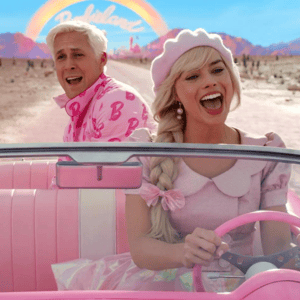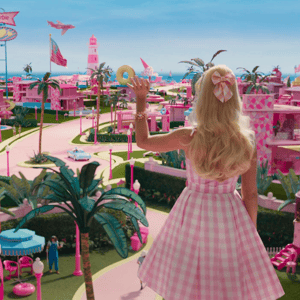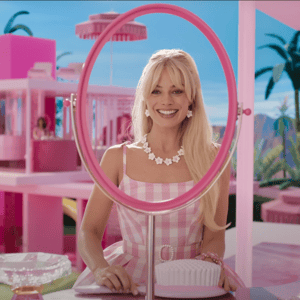Barbieland Versus the Real World
In all things pink this summer, we celebrated that Barbie can do anything. In fact, girls can be anything. Agree? Disagree?
What has drawn so many to leave the comfort of their own home to see this movie in an actual theater? In fact, as of mid-August, the Barbie movie has earned $1.18 BILLION through worldwide box office sales! According to interviews in Dexerto, Greta Gerwig, the writer and director of this summer's sensation, promised Hollywood it would attract viewers. Greta said, "And I think I told them that it'd make a billion dollars, which maybe I was overselling, but we had a movie to make, okay?" Conversely, Jeff Goldstein, the president of Domestic Distribution for Warner Bros. Pictures, said, "We have a pink unicorn here. We thought it would be $75 million for the opening weekend. Nobody saw $155 million coming. This doll has long legs." But, Jeff, Greta saw it coming! Barbie, the movie, has already broken the record for the fastest Warner Bros. film to gross $1B in 12 years. I think Greta and the women know why this movie is setting records. Do you?
In my work with leaders, I am more convinced than ever that we as women need to LEARN the gender biases that exist in today's world. We need to understand how to IDENTIFY such limiting behaviors in both us and with those whom we interact, be it at work, the community or in our home. Then we can further GROW our abilities to enact the antidote behaviors and mindsets in response to the limiting beliefs we encounter, be it from others or ourselves. We can UNLEASH our greatest transforming influence in the spaces and activities where we are passionate!
need to LEARN the gender biases that exist in today's world. We need to understand how to IDENTIFY such limiting behaviors in both us and with those whom we interact, be it at work, the community or in our home. Then we can further GROW our abilities to enact the antidote behaviors and mindsets in response to the limiting beliefs we encounter, be it from others or ourselves. We can UNLEASH our greatest transforming influence in the spaces and activities where we are passionate!
For those of you yet to indulge in this summer treasure, let's review the movie's premise and plot line and some ways it delved into the gender biases of today. (Spoiler alert!)
Women, the Barbies, are the dominant and ever-peppy force of Barbieland. In this pretend world, women are on Mt. Rushmore, make up the road crew, and populate the ranks of brain surgeons, pilots, presidents, supreme court justices, and astronauts. Women are everywhere! Barbie is shown winning a Pulitzer Prize and confidently and readily states she deserves it because she worked very hard. She accepts the award without surprise. She owns real estate, businesses and has an awesome house.
Simply put, every day is a great day, ev-er-y day. In fact, the waffles never burn, the tears don't flow, the heels fit comfortably, anxiety and thoughts of death are non-existent, and there's simply nothing to be afraid of. It's Barbieland! And it's PINK!
 But the real world begins to seep into Barbieland due to a rip between the two worlds. Only Barbie can mend the tear, so she takes off to the real world. But suddenly, she realizes and exclaims everything is reversed. There are men, men, MEN! And they are in charge of this world. She notices that men are looking at her like an object, and she doesn't like it. She encounters an all-male board running the Barbie company, and their answer to seeing she's come into their real world is to put her in a box complete with zip ties holding her back. She starts to feel anxious and can't put into words what she's afraid of but knows this is wrong.
But the real world begins to seep into Barbieland due to a rip between the two worlds. Only Barbie can mend the tear, so she takes off to the real world. But suddenly, she realizes and exclaims everything is reversed. There are men, men, MEN! And they are in charge of this world. She notices that men are looking at her like an object, and she doesn't like it. She encounters an all-male board running the Barbie company, and their answer to seeing she's come into their real world is to put her in a box complete with zip ties holding her back. She starts to feel anxious and can't put into words what she's afraid of but knows this is wrong.
Meanwhile, Ken tells her he feels great in this real world! Ken states, "Everyone really likes me and thinks I'm cool!" Ken proudly exclaims he's 'doing patriarchy and consumerism,' feeling he's finally unlocked the key to living in this real world. Ken takes his newfound sense of power and visibility back to Barbieland and creates Kendom by taking over the decorating and ownership of the houses, proudly naming his the Mojo Dojo Casa House. He installs a new government by the Kens and for the Kens. Every night is now declared boys' night, and the women serve the men, gloat over, and agree with the Kens' decisions. The land of men that Ken creates is modeled on what he saw of patriarchy in the real world and is now brought back to Kendom, where men are to push the Barbies around and down and take them for granted.
With the help of Sasha, a human Barbie fan, and her teenage daughter, Barbie returns to Barbieland and helps the Barbies break out of their patriarchal brainwashing and take back their home. But Barbie has learned too much in the real world. She finally grasps how living in Barbieland felt for Ken previously. She listens and learns that Ken believes his existence and happiness are only linked to when he receives attention from her. Barbie both empathetically yet firmly encourages him to find his own self. Ken admits that running Kendom with only the men in charge was hard. He also states he lost interest in patriarchy when he realized it wasn't just about horses. In the resultant transformed doll world, the Barbies remain primarily in power, but the Kens are present in some roles, too. Kens visibly serve as members of the lower courts, and 'Weird Barbie' and her Birkenstocks now also belong. After all these intentional changes, 'Stereotypical Barbie' no longer chooses to live in the pretend perfect world of Barbieland. She knows that waffles burn, tears flow, and mortality follows a human life. She believes she can make a difference in the real world, so she chooses to become real, like the Velveteen Rabbit. Barbie says, "I want to be a part of the people that make meaning, not the thing that is made."
charge was hard. He also states he lost interest in patriarchy when he realized it wasn't just about horses. In the resultant transformed doll world, the Barbies remain primarily in power, but the Kens are present in some roles, too. Kens visibly serve as members of the lower courts, and 'Weird Barbie' and her Birkenstocks now also belong. After all these intentional changes, 'Stereotypical Barbie' no longer chooses to live in the pretend perfect world of Barbieland. She knows that waffles burn, tears flow, and mortality follows a human life. She believes she can make a difference in the real world, so she chooses to become real, like the Velveteen Rabbit. Barbie says, "I want to be a part of the people that make meaning, not the thing that is made."
Go change the world, Barbie, develop a mutually beneficial partnership with the Kens and keep wearing PINK.
What are current gender realities, biases, and limiting beliefs for women in our very real world that Barbie also encountered? There are so many, but to name a few: confidence, communication, negotiation, advancement, male prototype leadership bias, childbearing bias, parenting bias, ageism, work/life harmony, (and no, I won't say 'balance!') safety, community-mindedness, niceness, decision-making abilities, financial prowess, and MORE! Pulling out each gender reality and bias hinted at in the Barbie movie would take another future blog for sure. I took pages of journal notes in the dark while watching the movie. A favorite part of the dialogue describes many challenges women navigate in the real world and makes up the entirety of Sasha's speech (the human Barbie fan mom). Which gender bias stood out most strongly to you from the movie?
Barbie has been controversial since I was a child. Axios writer Jennifer A. Kingson asks,
"Is she an empowering girl boss, or the person who made you feel inadequate about your braces, glasses, acne, and spreading thighs in 7th grade?"
"Do you see a beloved cultural icon who personifies innocence and childhood aspiration or an insidious villain who perpetuates unrealistic beauty standards and gender and racial stereotypes?"
 When designed and released in 1959 by Ruth Handler so little girls could play at being grown up, Barbie had body proportions that would have made her measurements in inches 39-21-33 in real life. (Robin Gerber) Jumping from paper dolls to buxom-endowed plastic dolls was too much for many early 1960's families to adopt readily without thinking they were sexualizing a doll for their child. In 1971, Mattel morphed Barbie into a career woman, changing her facial expression from a sideways submissive pose to a first-time straight-on power gaze. Consumers demanded Barbie look more like the women of their day, and her body dimensions became broader in 1998. Currently, 173,000 Barbies sell daily, and the Barbie doll holds the top spot for sales in the history of proprietary toy manufacturing. Barbie now sells in 175 different configurations and has had 250 careers. She is available in many skin colors and ethnic representations with choices for more global women to see themselves represented in this doll. There are larger frame Barbies, hijab-wearing Barbies, Barbies with hearing aids, wheelchairs, one identifying as Transgender, and another with Down syndrome. Barbie has definitely changed since 1959.
When designed and released in 1959 by Ruth Handler so little girls could play at being grown up, Barbie had body proportions that would have made her measurements in inches 39-21-33 in real life. (Robin Gerber) Jumping from paper dolls to buxom-endowed plastic dolls was too much for many early 1960's families to adopt readily without thinking they were sexualizing a doll for their child. In 1971, Mattel morphed Barbie into a career woman, changing her facial expression from a sideways submissive pose to a first-time straight-on power gaze. Consumers demanded Barbie look more like the women of their day, and her body dimensions became broader in 1998. Currently, 173,000 Barbies sell daily, and the Barbie doll holds the top spot for sales in the history of proprietary toy manufacturing. Barbie now sells in 175 different configurations and has had 250 careers. She is available in many skin colors and ethnic representations with choices for more global women to see themselves represented in this doll. There are larger frame Barbies, hijab-wearing Barbies, Barbies with hearing aids, wheelchairs, one identifying as Transgender, and another with Down syndrome. Barbie has definitely changed since 1959.
Although the movie highlighted many types of Barbie, the main stars were still blond, beautiful, and light-skinned. Should Greta, the Barbie movie writer and director, have been even bolder in her casting?
How is this movie affecting you? When have you felt like Barbie, or do you continue to be put in a box with your hands tied? I'd love to hear!
I educate and help women leaders LEARN, IDENTIFY, GROW, AND UNLEASH their superpowers to change their corner of the world. Do you know a group of women leaders that would benefit from this resourcing? Let me know. And let's go see the Barbie movie again. Greta, I can't wait for your next film!
Transforming influence alongside you,

What I’m Reading:
- Barbie and Ruth by Robin Gerber. I'm re-reading this after 14 years and this summer's box office sensation of the Barbie movie. It's an insightful look at the passion and perseverance that Ruth Handler showed in bringing her dream to life. The book discusses how she, too, was a part of the cultural influences of her day and yet receptive enough to new beliefs to push the envelope.
- McKinsey and Company's Newsletter, Mind__ the Gap, whose August 15 issue was full of helpful links FOR THE GIRLS, as they said in a summer of Barbie.
- "Women in Leadership Face Ageism at Every Age" by Amy Diehl, Leanne M. Dzubinski, and Amer L. Stephenson (Harvard Business Review). I find anything Amy authors helpful concerning understandable research and examples of how women face differing gender realities. In this article, it's the Goldilocks struggle, as it's sometimes referred to that women are too old, too young, and hard to be deemed a "just right" age in the workplace.
- And the Summer of 2023 means listening to the Barbie soundtrack!

August 24, 2023

Comments